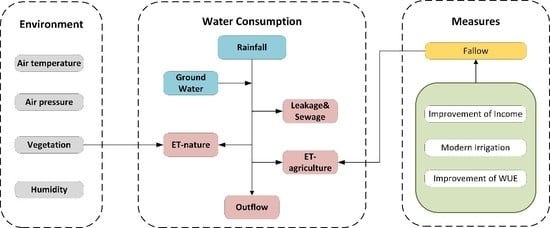Satellite-Based Water Consumption Dynamics Monitoring in an Extremely Arid Area
Abstract
1. Introduction
2. Materials and Methods
2.1. Research Area
2.2. Monitoring Framework
2.3. Satellite Data
2.4. Other Data
2.4.1. Land Cover and Crop Maps
2.4.2. Ancillary Datasets
2.5. Trend Analysis
3. Results and Analysis
3.1. Evaluation of ET Estimates
3.2. Water Consumption Dynamics
3.3. Agricultural Water Consumption
3.4. Ecological Water Consumption
4. Discussion
5. Conclusions
Author Contributions
Acknowledgments
Conflicts of Interest
References
- Engelen, J.V.; Essink, G.H.P.O.; Kooi, H.; Bierkens, M.F.P. On the origins of hypersaline groundwater in the nile delta aquifer. J. Hydrol. 2018. [Google Scholar] [CrossRef]
- Gleick, P.H. Water, drought, climate change, and conflict in syria. Weather Clim. Soc. 2013, 6, 331–340. [Google Scholar] [CrossRef]
- Li, M.; Guo, P.; Singh, V.P.; Yang, G. An uncertainty-based framework for agricultural water-land resources allocation and risk evaluation. Agric. Water Manag. 2016, 177, 10–23. [Google Scholar] [CrossRef]
- Dai, Z.Y.; Li, Y.P. A multistage irrigation water allocation model for agricultural land-use planning under uncertainty. Agric. Water Manag. 2013, 129, 69–79. [Google Scholar] [CrossRef]
- Fasakhodi, A.A.; Nouri, S.H.; Amini, M. Water resources sustainability and optimal cropping pattern in farming systems; a multi-objective fractional goal programming approach. Water Resour. Manag. 2010, 24, 4639–4657. [Google Scholar] [CrossRef]
- Grafton, R.Q. Editorial: Water reform and planning in the murray–darling basin, australia. Water Econ. Policy 2017, 3, 1702001. [Google Scholar] [CrossRef]
- Sethi, L.N.; Panda, S.N.; Nayak, M.K. Optimal crop planning and water resources allocation in a coastal groundwater basin, Orissa, India. Agric. Water Manag. 2006, 83, 209–220. [Google Scholar] [CrossRef]
- Yun, C.; Chenghaw, L.; Tan, Y.C.; Hsinfu, Y. An optimal water allocation for an irrigation district in pingtung county, Taiwan. Irrig. Drain. 2009, 58, 287–306. [Google Scholar]
- Bavi, A.; Kashkuli, H.A.; Boroomand, S.; Naseri, A.; Albaji, M. Evaporation losses from sprinkler irrigation systems under various operating conditions. J. Appl. Sci. 2009, 9, 597–600. [Google Scholar] [CrossRef]
- Su, Z. The surface energy balance system (sebs) for estimation of turbulent heat fluxes. Hydrol. Earth Syst. Sci. 2002, 6, 85–99. [Google Scholar] [CrossRef]
- Perry, C. Accounting for water use: Terminology and implications for saving water and increasing production. Agric. Water Manag. 2011, 98, 1840–1846. [Google Scholar] [CrossRef]
- Qin, S.; Li, S.; Kang, S.; Du, T.; Tong, L.; Ding, R. Can the drip irrigation under film mulch reduce crop evapotranspiration and save water under the sufficient irrigation condition? Agric. Water Manag. 2016, 177, 128–137. [Google Scholar] [CrossRef]
- Qi, S.; Luo, F. Environmental degradation problems in the Heihe River Basin, Northwest China. Water Environ. J. 2007, 21, 142–148. [Google Scholar] [CrossRef]
- Mu, Q.; Heinsch, F.A.; Zhao, M.; Running, S.W. Development of a global evapotranspiration algorithm based on modis and global meteorology data. Remote Sens. Environ. 2007, 111, 519–536. [Google Scholar] [CrossRef]
- Wu, B.; Yan, N.; Xiong, J.; Bastiaanssen, W.G.M.; Zhu, W.; Stein, A. Validation of etwatch using field measurements at diverse landscapes: A case study in hai basin of China. J. Hydrol. 2012, 436–437, 67–80. [Google Scholar] [CrossRef]
- Wu, B.; Zhu, W.; Yan, N.; Feng, X.; Xing, Q.; Zhuang, Q. An improved method for deriving daily evapotranspiration estimates from satellite estimates on cloud-free days. IEEE J. Sel. Top. Appl. Earth Obs. Remote Sens. 2016, 9, 1323–1330. [Google Scholar] [CrossRef]
- Bastiaanssen, W.G.M.; Pelgrum, H.; Wang, J.; Ma, Y.; Moreno, J.F.; Roerink, G.J.; Wal, T.V.D. A remote sensing surface energy balance algorithm for land (sebal). Part 2: Validation. J. Hydrol. 1998, 212, 213–229. [Google Scholar] [CrossRef]
- Timmermans, W.J.; Kustas, W.P.; Anderson, M.C.; French, A.N. An intercomparison of the surface energy balance algorithm for land (sebal) and the two-source energy balance (tseb) modeling schemes. Remote Sens. Environ. 2007, 108, 369–384. [Google Scholar] [CrossRef]
- Li, J.; Zhu, T.; Mao, X.; Adeloye, A.J. Modeling crop water consumption and water productivity in the middle reaches of heihe river basin. Comput. Electron. Agric. 2016, 123, 242–255. [Google Scholar] [CrossRef]
- Roerink, G.J.; Bastiaanssen, W.G.M.; Chambouleyron, J.; Menenti, M. Relating crop water consumption to irrigation water supply by remote sensing. Water Resour. Manag. 1997, 11, 445–465. [Google Scholar] [CrossRef]
- Wu, B.; Zeng, H.; Yan, N.; Zhang, M. Approach for estimating available consumable water for human activities in a river basin. Water Resour. Manag. 2018. [Google Scholar] [CrossRef]
- Anderson, M.C.; Allen, R.G.; Morse, A.; Kustas, W.P. Use of landsat thermal imagery in monitoring evapotranspiration and managing water resources. Remote Sens. Environ. 2012, 122, 50–65. [Google Scholar] [CrossRef]
- Senay, G.B.; Friedrichs, M.K.; Singh, R.K.; Velpuri, N.M. Evaluating landsat 8 evapotranspiration for water use mapping in the colorado river basin. Remote Sens. Environ. 2016, 185, 171–185. [Google Scholar] [CrossRef]
- Senay, G.B.; Schauer, M.; Friedrichs, M.K.; Velpuri, N.M.; Singh, R.K. Satellite-based water use dynamics using historical landsat data (1984–2014) in the southwestern united states. Remote Sens. Environ. 2017. [Google Scholar] [CrossRef]
- Goes, B.J.M.; Parajuli, U.N.; Haq, M.; Wardlaw, R.B. Karez (qanat) irrigation in the helmand river basin, afghanistan: A vanishing indigenous legacy. Hydrogeol. J. 2017, 25, 269–286. [Google Scholar] [CrossRef]
- Bing-Fang, W.U.; Xiong, J.; Yan, N.N.; Yang, L.D.; Xin, D.U. Etwatch for monitoring regional evapotranspiration with remote sensing. Adv. Water Sci. 2008, 19, 671–678. [Google Scholar]
- Xu, Z.W.; Liu, S.M.; Gong, L.J.; Wang, J.M.; Li, X.W. A study on the data processing and quality assessment of the eddy covariance system. Adv. Earth Sci. 2008, 23, 357–370. [Google Scholar]
- Afsin Gungor, U.Y. Global solar radiation estimation using sunshine duration in nigde. Energy Convers. Manag. 2014, 45, 1529–1535. [Google Scholar]
- Hargreaves, G.L.; Hargreaves, G.H.; Riley, J.P. Irrigation water requirement for the senegal river basin. J irrig drain e-asce. J. Irrig. Drain. Eng. 1985, 111, 265–275. [Google Scholar] [CrossRef]
- Supit, I.; Kappel, R.V. A simple method to estimate global radiation. Sol. Energy 1998, 63, 147–160. [Google Scholar] [CrossRef]
- Wu, B.; Liu, S.; Zhu, W.; Yan, N.; Xing, Q.; Tan, S. An improved approach for estimating daily net radiation over the heihe river basin. Sensors 2017, 17, 86. [Google Scholar] [CrossRef] [PubMed]
- Wu, B.; Liu, S.; Zhu, W.; Yu, M.; Yan, N.; Xing, Q. A method to estimate sunshine duration using cloud classification data from a geostationary meteorological satellite (fy-2d) over the heihe river basin. Sensors 2016, 16, 1859. [Google Scholar] [CrossRef] [PubMed]
- Feng, X.; Wu, B.; Yan, N. A method for deriving the boundary layer mixing height from modis atmospheric profile data. Atmosphere 2015, 6, 1346–1361. [Google Scholar] [CrossRef]
- Monteith, J.L. Evaporation and environment. Symp. Soc. Exp. Biol. 1965, 19, 205–234. [Google Scholar] [PubMed]
- Tan, S.; Wu, B.; Yan, N.; Zhu, W. An ndvi-based statistical et downscaling method. Water 2017, 9, 995. [Google Scholar] [CrossRef]
- Zhang, A.L.; Li, X.; Yuan, Q.; Liu, Y. Object-based approach to national land cover mapping using hj satellite imagery. J. Appl. Remote Sens. 2014, 8, 464–471. [Google Scholar] [CrossRef]
- Ouyang, Z.; Zheng, H.; Xiao, Y.; Polasky, S.; Liu, J.; Xu, W.; Wang, Q.; Zhang, L.; Xiao, Y.; Rao, E. Improvements in ecosystem services from investments in natural capital. Science 2016, 352, 1455–1459. [Google Scholar] [CrossRef] [PubMed]
- Pekel, J.F.; Cottam, A.; Gorelick, N.; Belward, A.S. High-resolution mapping of global surface water and its long-term changes. Nature 2016, 540, 418–422. [Google Scholar] [CrossRef] [PubMed]
- Kendall, M.G. A new measure of rank correlation. Biometrika 1938, 30, 81–93. [Google Scholar] [CrossRef]
- Douglas, E.M.; Vogel, R.M.; Kroll, C.N. Trends in floods and low flows in the United States: Impact of spatial correlation. J. Hydrol. 2000, 240, 90–105. [Google Scholar] [CrossRef]
- Hirsch, R.M.; Slack, J.R. A nonparametric trend test for seasonal data with serial dependence. Water Resour. Res. 1984, 20, 727–732. [Google Scholar] [CrossRef]
- Yan, N.; Tian, F.; Wu, B.; Zhu, W.; Yu, M. Spatiotemporal analysis of actual evapotranspiration and its causes in the Hai Basin. Remote Sens. 2018, 10, 332. [Google Scholar] [CrossRef]
- Savitzky, A.; Golay, M.J.E. Smoothing and differentiation of data by simplified least squares procedures. Anal. Chem. 1964, 36, 1627–1639. [Google Scholar] [CrossRef]
- Du, T.; Kang, S.; Zhang, J.; Davies, W.J. Deficit irrigation and sustainable water-resource strategies in agriculture for China’s food security. J. Exp. Bot. 2015, 66, 2253–2269. [Google Scholar] [CrossRef] [PubMed]
- Li, X.; Zhang, X.; Niu, J.; Tong, L.; Kang, S.; Du, T.; Li, S.; Ding, R. Irrigation water productivity is more influenced by agronomic practice factors than by climatic factors in Hexi Corridor, Northwest China. Sci. Rep. 2016, 6, 37971. [Google Scholar] [CrossRef] [PubMed]
- Jackson, R.B.; Murray, B.C. Trading water for carbon with biological carbon sequestration. Science 2005, 310, 1944–1947. [Google Scholar] [CrossRef] [PubMed]
- Subin, Z.M.; Riley, W.J.; Mironov, D. An improved lake model for climate simulations: Model structure, evaluation, and sensitivity analyses in cesm1. J. Adv. Model. Earth Syst. 2012, 4. [Google Scholar] [CrossRef]
- Norman, J.M.; Anderson, M.C.; Kustas, W.P.; French, A.N.; Mecikalski, J.; Torn, R.; Diak, G.R.; Schmugge, T.J.; Tanner, B.C.W. Remote sensing of surface energy fluxes at 101-m pixel resolutions. Water Resour. Res. 2003, 39. [Google Scholar] [CrossRef]
- Zhuang, Q.; Wu, B.; Yan, N.; Zhu, W.; Xing, Q. A method for sensible heat flux model parameterization based on radiometric surface temperature and environmental factors without involving the parameter kb−1. Int. J. Appl. Earth Obs. Geoinf. 2016, 47, 50–59. [Google Scholar] [CrossRef]
- Liu, J.; Li, S.; Ouyang, Z.; Tam, C.; Chen, X. Ecological and socioeconomic effects of China’s policies for ecosystem services. Proc. Natl. Acad. Sci. USA 2008, 105, 9477–9482. [Google Scholar] [CrossRef] [PubMed]
- Ma, C.; Luo, Y.; Shao, M.; Li, X.; Sun, L.; Jia, X. Environmental controls on sap flow in black locust forest in Loess Plateau, China. Sci. Rep. 2017, 7, 13160. [Google Scholar] [CrossRef] [PubMed]
- Yang, Y.; Watanabe, M.; Zhang, X.; Hao, X.; Zhang, J. Estimation of groundwater use by crop production simulated by dssat-wheat and dssat-maize models in the piedmont region of the north china plain. Hydrol. Process. 2010, 20, 2787–2802. [Google Scholar] [CrossRef]
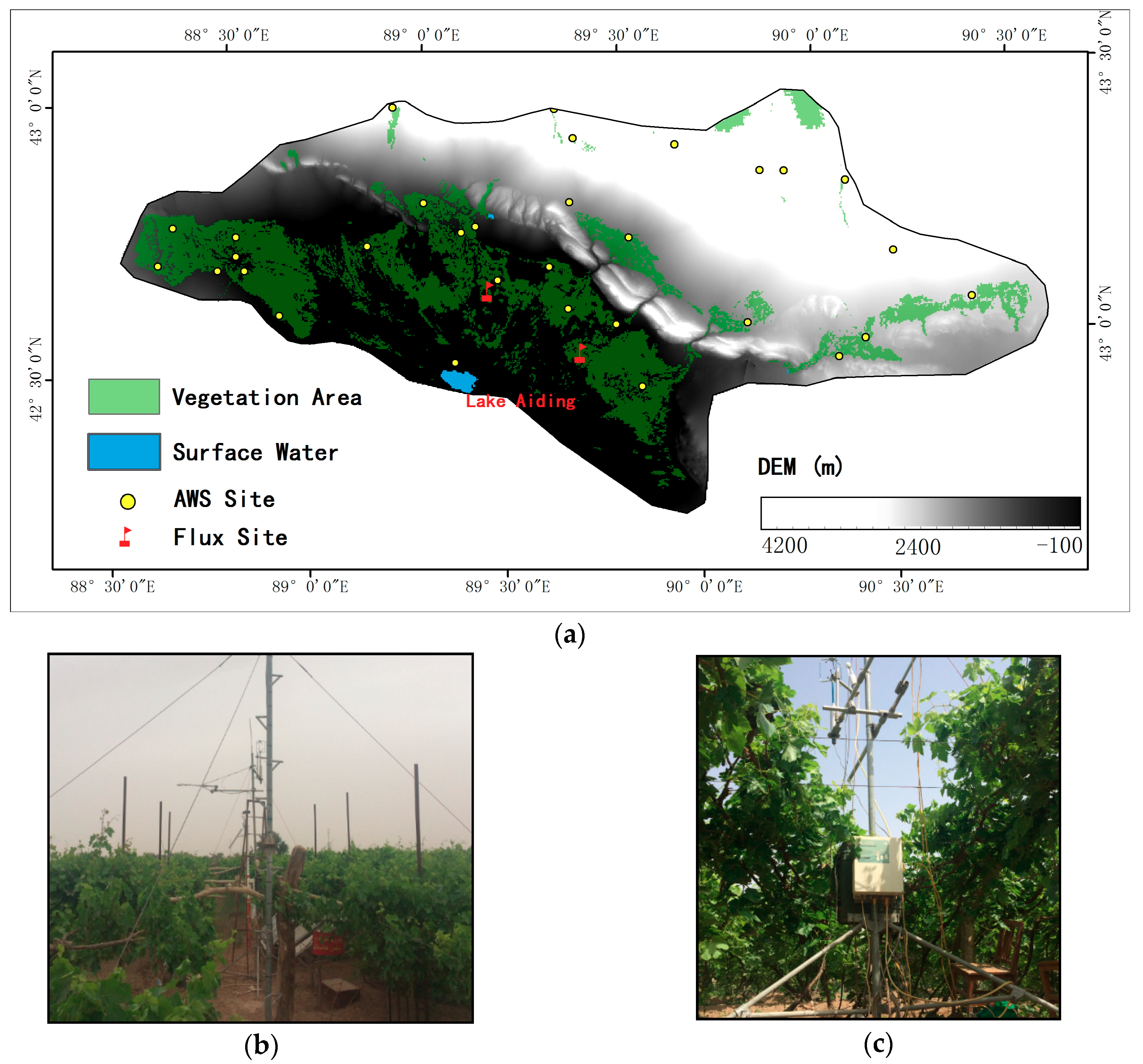
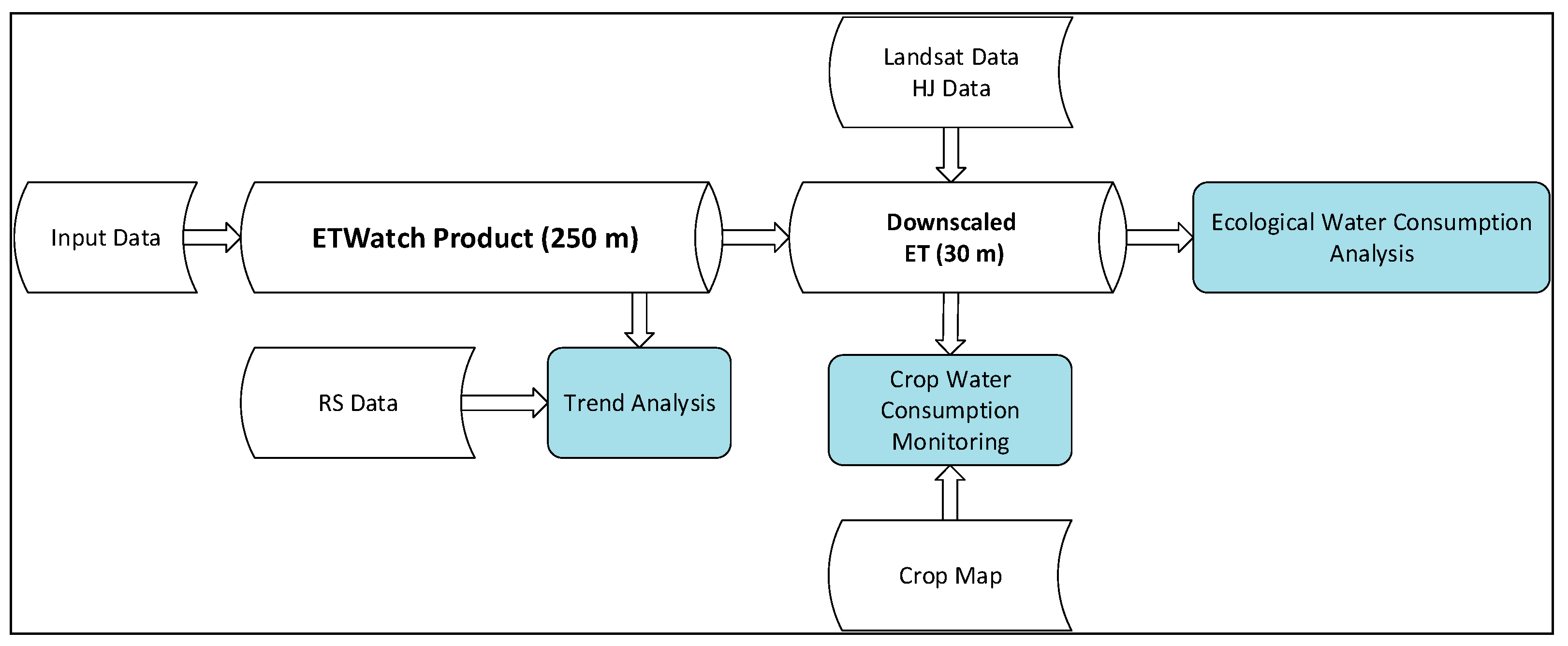

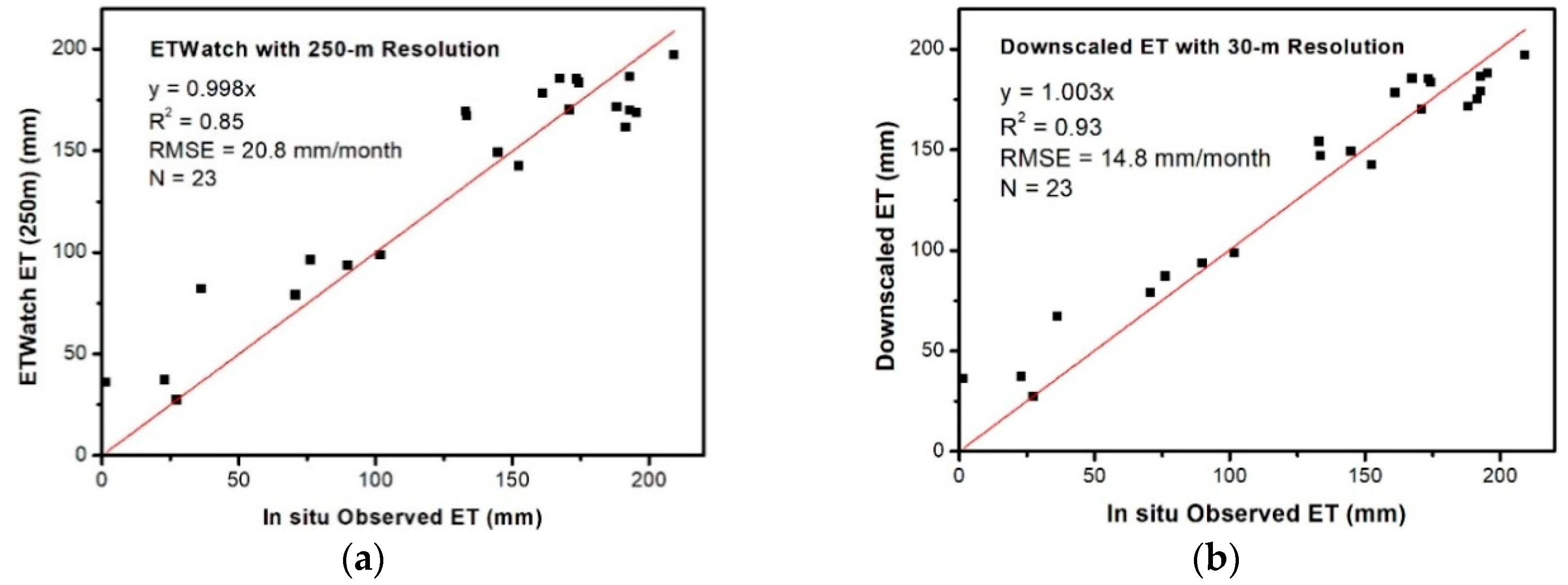
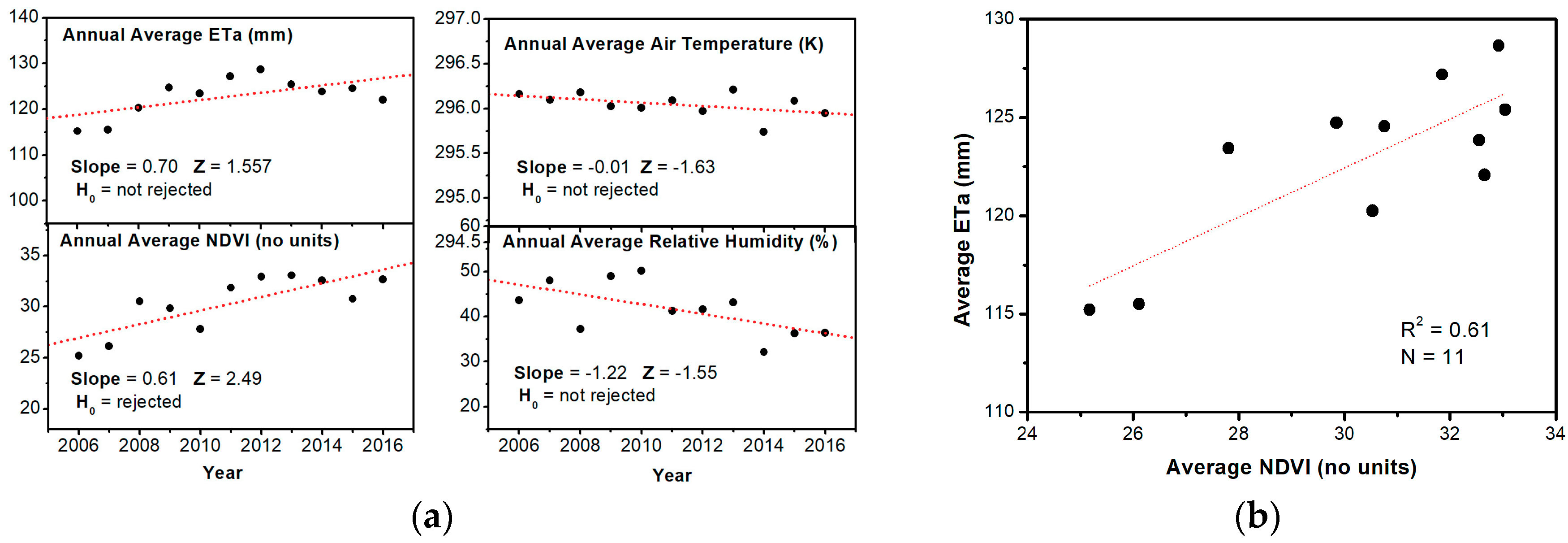
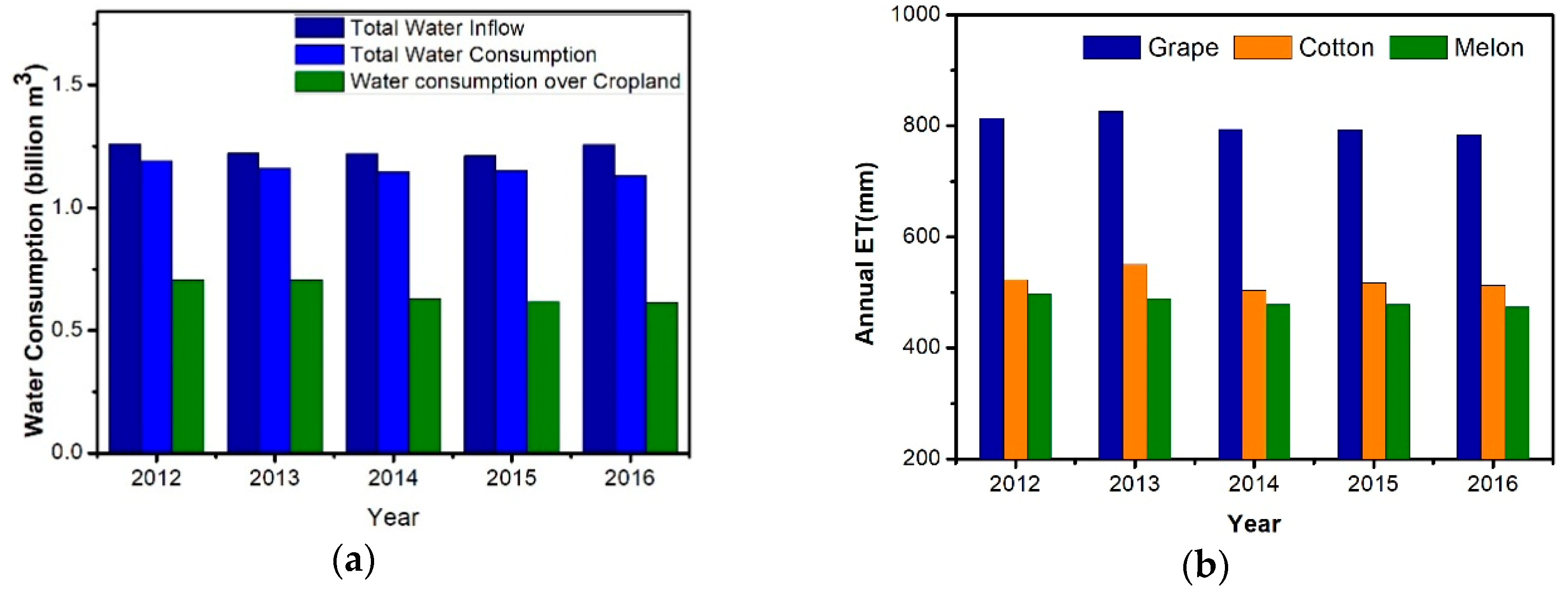

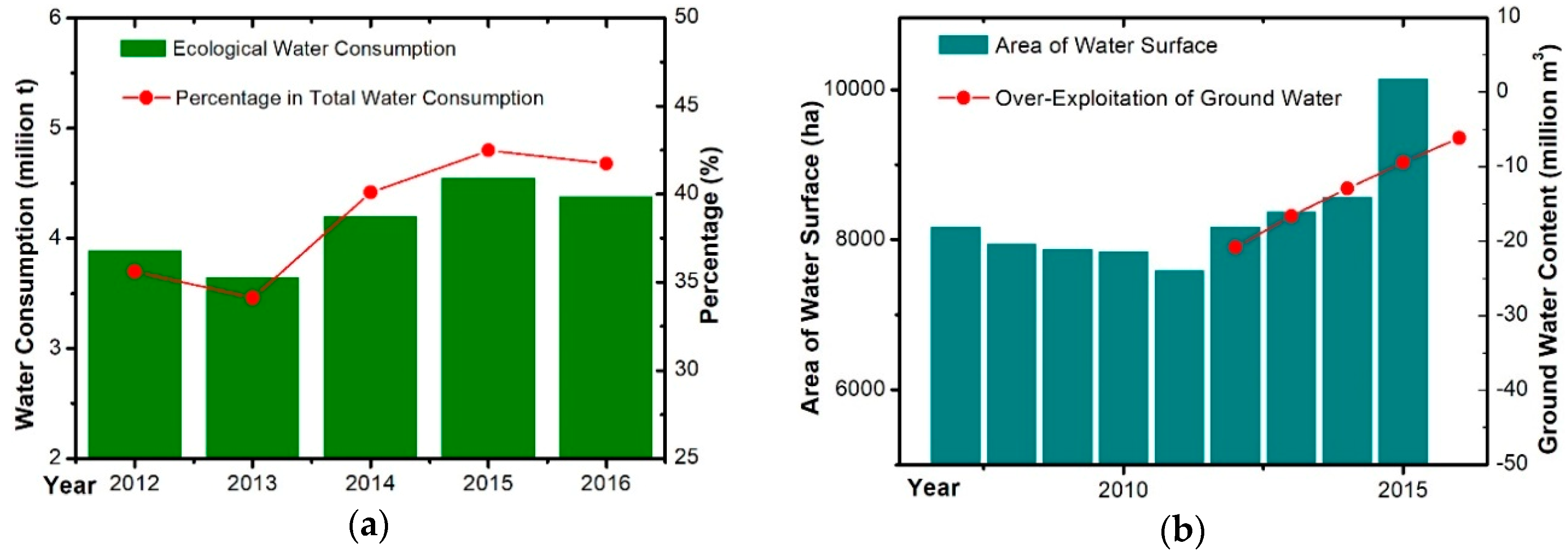
| Crop Type | 2012 | 2013 | 2014 | 2015 | 2016 |
|---|---|---|---|---|---|
| Grape | 28.97 | 33.59 | 34.64 | 34.70 | 34.91 |
| Cotton | 48.07 | 31.00 | 21.30 | 16.93 | 12.31 |
| Melon | 0.41 | 1.58 | 9.23 | 7.03 | 9.19 |
| Other crops | 17.06 | 21.57 | 19.66 | 25.06 | 25.10 |
| Total | 94.50 | 87.74 | 84.83 | 83.72 | 81.51 |
© 2018 by the authors. Licensee MDPI, Basel, Switzerland. This article is an open access article distributed under the terms and conditions of the Creative Commons Attribution (CC BY) license (http://creativecommons.org/licenses/by/4.0/).
Share and Cite
Tan, S.; Wu, B.; Yan, N.; Zeng, H. Satellite-Based Water Consumption Dynamics Monitoring in an Extremely Arid Area. Remote Sens. 2018, 10, 1399. https://doi.org/10.3390/rs10091399
Tan S, Wu B, Yan N, Zeng H. Satellite-Based Water Consumption Dynamics Monitoring in an Extremely Arid Area. Remote Sensing. 2018; 10(9):1399. https://doi.org/10.3390/rs10091399
Chicago/Turabian StyleTan, Shen, Bingfang Wu, Nana Yan, and Hongwei Zeng. 2018. "Satellite-Based Water Consumption Dynamics Monitoring in an Extremely Arid Area" Remote Sensing 10, no. 9: 1399. https://doi.org/10.3390/rs10091399
APA StyleTan, S., Wu, B., Yan, N., & Zeng, H. (2018). Satellite-Based Water Consumption Dynamics Monitoring in an Extremely Arid Area. Remote Sensing, 10(9), 1399. https://doi.org/10.3390/rs10091399






